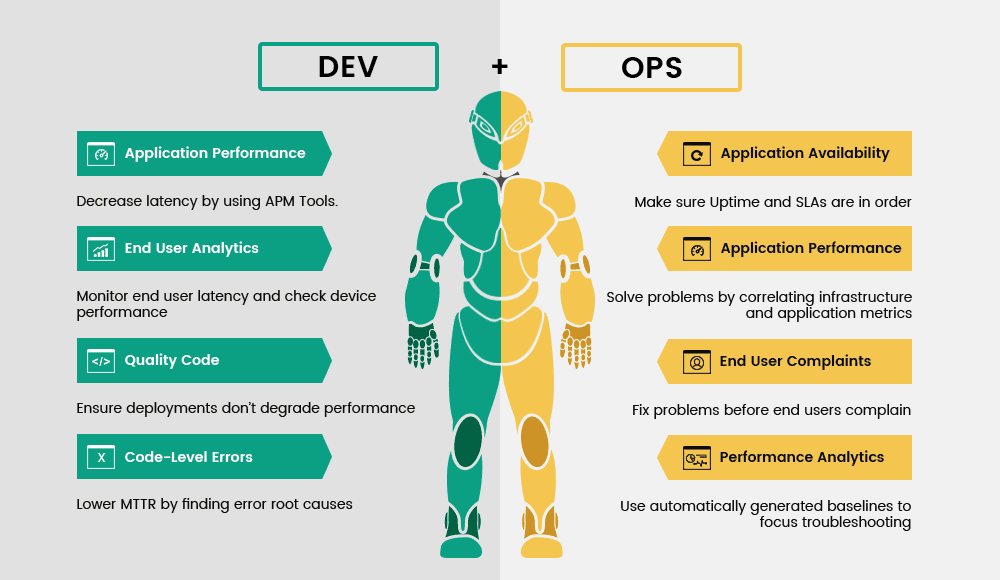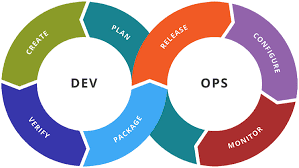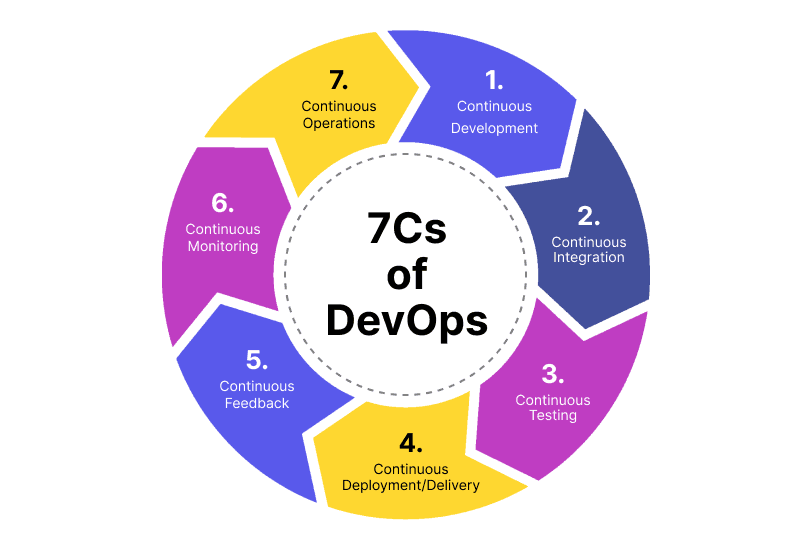What is DevOps?
DevOps is a software development approach that combines development (Dev) & operations (Ops) to enable faster, more reliable delivery of applications and services. DevOps focuses on collaboration, automation, & continuous improvement throughout the software development lifecycle.
You might ask what is the goal of DevOps methodology? The goal of DevOps methodology is to deliver customer values quickly by decreasing the development lifecycle while maintaining high quality. Learn more about DevOps & the benefits of DevOps for your enterprises through this blog:
The 7 Phases of the DevOps Lifecycle
The ultimate goal of the DevOps methodology is to deliver high-quality software faster & with more efficiency. To achieve this, the DevOps lifecycle phases consist of several key phases that work together seamlessly. DevOps lifecycle is a continuous loop, with each phase building upon the previous one. Let's break it down:
Plan: In the DevOps lifecycle planning phase, teams collaborate to define project requirements, set goals, and create a roadmap for the development process.
Code: Next up, the development team gets their hands dirty and starts coding the software. Developers use version control tools like Git to manage and track changes to the codebase. Collaboration is key here!
Build: Once the code is ready, it's time to build the software. Continuous integration tools like Jenkins or Travis CI come into play, automatically building and testing the code to catch any issues early on.
Test: In this phase, the software undergoes rigorous testing to ensure it meets the desired quality standards. Automated testing tools like Selenium or JUnit are used to streamline the process and catch any bugs before they become a problem.
Release: When the software passes all the tests with flying colors, it's ready for release. This DevOps lifecycle phase involves packaging the software and preparing it for deployment to production environments.
Deploy: The software is deployed to production servers, making it available to end-users. Continuous deployment tools like Ansible or Kubernetes automate the process, ensuring smooth & efficient deployments.
Operate: Once the software is live, it's crucial to keep it running smoothly. The operations team monitors the software's performance, identifies any issues, & ensures high availability. Tools like Nagios or Prometheus help in monitoring and alerting.
Monitor: Continuous monitoring is an essential DevOps lifecycle phase to gather valuable insights and feedback. By analyzing user behavior, application performance, & system health, teams can identify areas for improvement and make data-driven decisions.
7 Cs of DevOps
Learning DevOps is essential for mastering the intricacies of the DevOps lifecycle phases. The DevOps lifecycle encompasses seven key components, known as the seven Cs:
1. Continuous Development
The primary goal of this Continuous Development DevOps lifecycle phase is to plan and code the software in small, manageable increments. This phase involves gathering requirements, defining the project vision, and writing the initial code.
Key Practices:
Planning: Teams collaborate with stakeholders to define project requirements and create a roadmap. Tools like Jira or Trello are often used to manage tasks and user stories.
Coding: Developers write code using best practices to ensure it is maintainable and scalable. Version control systems like Git are used to manage code changes.
2. Continuous Integration
Continuous Integration (CI) aims to integrate code changes frequently and automatically test them to detect issues early. This phase ensures that the codebase remains stable and functional.
Key Practices:
Frequent Commits: Developers commit code changes to a shared repository multiple times a day.
Automated Builds and Tests: Tools like Jenkins or Travis CI are used to automate the build process and run unit tests on each commit. This helps identify integration issues early on.
3. Continuous Testing
The goal of Continuous Testing is to ensure that the software is continuously tested for bugs and performance issues throughout the development lifecycle. This phase helps maintain high software quality.
Key Practices:
Automated Testing: Automated tests, including unit, integration, and performance tests, are run using tools like Selenium or JUnit.
Test Environments: Testing is performed in environments that closely mimic production to ensure reliability.
4. Continuous Deployment
Continuous Deployment (CD) aims to automate the release of software to production environments. This phase ensures that new features and fixes are delivered to users quickly and reliably.
Key Practices:
Automated Deployment Pipelines: Tools like AWS CodeDeploy or Azure DevOps are used to automate the deployment process.
Infrastructure as Code (IaC): Configuration management tools like Ansible or Terraform are used to manage infrastructure, ensuring consistency across environments.
5. Continuous Monitoring
The goal of Continuous Monitoring is to track the performance and health of the application in real-time. This phase helps identify and resolve issues before they impact users.
Key Practices:
Monitoring Tools: Tools like Prometheus, Grafana, or New Relic are used to monitor application performance and system health.
Alerting: Automated alerts are set up to notify teams of any anomalies or issues that require immediate attention.
6. Continuous Feedback
Continuous Feedback aims to gather insights from users and stakeholders to improve the software continuously. This phase ensures that the development process is aligned with user needs and expectations.
Key Practices:
User Feedback: Collect feedback through surveys, user testing, and analytics tools.
Retrospectives: Conduct regular retrospectives to discuss what went well and what could be improved, fostering a culture of continuous improvement.
7. Continuous Operations
The goal of Continuous Operations is to ensure the application runs smoothly and efficiently in production. This phase focuses on maintaining high availability and performance.
Key Practices:
Operational Automation: Automate routine operational tasks using tools like Chef or Puppet.
Disaster Recovery: Implement robust disaster recovery plans to ensure quick recovery from failures.
Also, Read: How to Implement Artificial Intelligence in DevOps Transformation?
Best Practices for an Effective DevOps Lifecycle
Have a Centralized Unit for DevOps
Centralized Coordination: Establish a dedicated DevOps team that oversees the entire lifecycle. This team should be responsible for integrating development and operations, ensuring seamless communication and collaboration.
Unified Goals: Align the objectives of development and operations teams to work towards common goals, reducing silos and fostering a collaborative environment.
Shift Left with CI/CD
Continuous Integration (CI): This practice involves developers frequently integrating their code changes into a shared repository. Each integration is automatically tested to detect issues early, ensuring that the main codebase remains stable. CI is a fundamental part of the DevOps lifecycle.
Continuous Delivery (CD): CD extends CI by automatically deploying all code changes to a testing or production environment after the build stage. This ensures that the software can be released reliably at any time, making it a key component of the DevOps lifecycle phases.
Benefits: Shifting left with CI/CD means incorporating testing and quality checks early in the development process, which helps in identifying and fixing issues sooner, reducing the cost and effort required to address them later.
View the Entire Lifecycle Holistically
End-to-End Perspective: Consider the entire software development lifecycle from planning to deployment and beyond. This holistic view helps in identifying potential bottlenecks and areas for improvement within the DevOps lifecycle.
Cross-Functional Collaboration: Encourage collaboration across all teams involved in the lifecycle, including development, operations, QA, and security. This ensures that everyone is aligned and working towards the same objectives within the DevOps lifecycle phases.
Encourage Cross-Team Autonomy and Responsibility
Empower Teams: Give teams the autonomy to make decisions and take ownership of their work. This fosters a sense of responsibility and pride in their contributions which is essential for an effective DevOps lifecycle.
Shared Accountability: Promote a culture where both development and operations teams share responsibility for the software they build and maintain. This reduces the knowledge gap and improves overall productivity within the DevOps lifecycle phases.
Embrace Automation Wherever Possible
Automate Repetitive Tasks: Use automation tools to handle repetitive and manual tasks such as testing, deployment, and monitoring. Automating not only speeds up the process but also reduces the risk of human error, enhancing the efficiency of the DevOps lifecycle.
Continuous Improvement: Regularly review and update your automation processes to ensure they remain efficient and effective, which is crucial for a streamlined DevOps lifecycle.
Cultivate a Learning Mindset and Continuously Improve
Foster a Learning Culture: Encourage continuous learning and improvement within your teams. Provide opportunities for training, attending conferences, & experimenting with new tools and technologies to enhance the DevOps lifecycle.
Blameless Retrospectives: Conduct regular retrospectives to discuss what went well and what could be improved. Creating a safe environment where your team members can share their experiences without fear of blame, is extremely important for continuous improvement in the DevOps lifecycle.
Feedback Loops: Implement continuous feedback mechanisms to gather insights from all stages of the lifecycle. Use this feedback to make informed decisions & drive improvements, ensuring the DevOps lifecycle remains dynamic and efficient.
Final Thoughts
DevOps lifecycle phases are a proven roadmap to faster, more reliable releases and happier customers. Let's ditch the bottlenecks & foster collaboration, automation, and continuous improvement. The result? A streamlined development process, supercharged team efficiency, & the agility to outpace the competition.
Tired of those nail-biting deployments and endless troubleshooting sessions? Be part of a world with SoluteLabs where your software delivery is seamless, reliable, and lightning-fast. We'll equip your team with the tools and strategies to not just deploy, but dominate your delivery pipeline. Contact us to transform your DevOps process into a competitive advantage.









